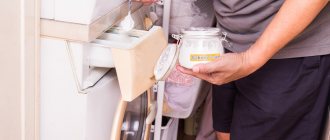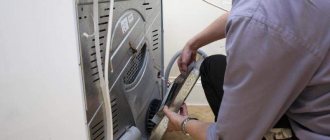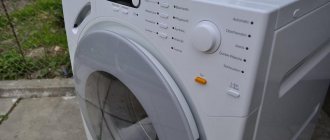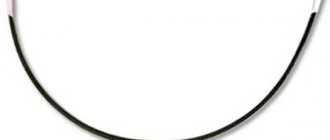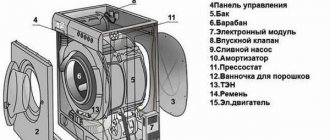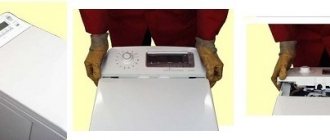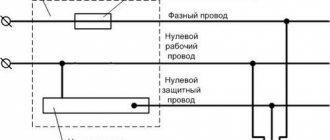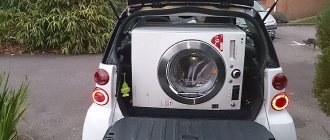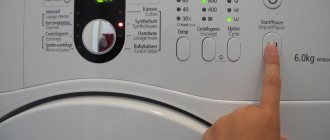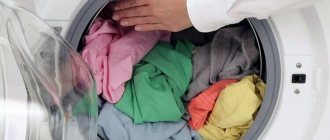Doing laundry at the dacha is a difficult task. You can use a washboard or just your hands, but this is long, inconvenient and difficult. It is necessary to develop the possibility of installing a washing machine, but how to connect an automatic washing machine in a country house without running water?
A washing machine without a water supply connection with a water tank is a great idea for those who are not afraid to improve the quality of their life with their own hands. Let's look at the features, instructions and options for connecting a washing machine in a country house without a centralized water supply.
Washing machine for a dacha without running water - profitable and convenient
All you need is water and electricity. Even in old dacha cooperatives there are no problems with electricity. Unstable, periodic, with low voltage, but it is there.
Connecting a washing machine if there is no running water
And plumbing has still not been installed in most private areas in the CIS. It's not difficult to imitate a drain. It is enough to take the pipe to the toilet or prepare the tank in advance. The main thing is the availability of electricity.
As for water supply, you can choose from:
- well;
- well;
- rain.
Even in the absence of a permanent source of water, you can take advantage of the rain that often falls during the summer season.
Requirements for connecting a washing machine
Before you connect an automatic washing machine without running water, you need to know the conditions for its operation:
- Electricity. While it is possible to install an automatic washing machine without running water, it will not operate without electricity. The equipment operates from a standard 220 Volt network. Consumes from one to one and a half kilowatts of energy. To install such a machine without electricity, you need a generator with a power of at least two kilowatts.
- Water. It is needed to wash things. The equipment consumes about 60 liters per cycle. You can use a barrel or well. But you need pressure (at least one bar). To ensure this condition, an additional pump operating from the network is purchased. But there are also alternative options. We'll tell you about them later.
- Sewerage. After washing, dirty water should leave the washing machine, which is 40-60 liters. Before installing the equipment, a place is provided where the liquid will drain. It is recommended to connect to a waste disposal system. A cesspool is used for this purpose. If this is not possible, the old water is poured into the yard. But the danger is that dirty water is saturated with powder. Such liquid harms the growth of fruits and vegetables that are planted in the ground. If the drain is taken outside, it should be away from living plants.
Ways to connect an automatic washing machine in a country house without running water
There are many options. For the average summer resident, 4 installation methods are immediately available without connecting to a water supply.
Container for detergents
The simplest and most cost-effective method that does not require investment. In machines with horizontal loading, it is possible to add water during the washing process. This is done through the powder collection compartment.
How to pour water into a washing machine at the dacha
Pros:
- Price. No need to spend money on a pump or additional equipment. You don't even need hoses and tubes. A bucket or any other container is enough to pour the liquid inside.
- Simplicity. You don't even need a tool for assembly. If you don’t understand anything about the workings of a washing machine and don’t want to figure it out, this is your option.
Minuses:
- Inconvenience. It turns out to be an ordinary machine with manual filling. Conventional semi-automatic Soviet devices, which can hardly be called convenient, work exactly on the same principle. A constant presence is required to monitor the water level and add it as needed.
- Limitation. Some programs will not be able to be used because the thermal electric heater is not activated.
If you are willing to put up with the inconvenience, you can use this method.
Water tank
Semi-automatic installation method. It involves installing a water tank at a certain height, which flows by gravity into the washing machine in the traditional way. The hose from the container goes to the water intake hole.
The simplest and most effective option: a water tank
If you have a suitable container, this method will be the easiest and least expensive. The tank can be anything: metal, wood, plastic.
Pros:
- Automatism. No human presence is required. While the washing is happening, you can go about your business. You don’t have to worry about the design – it has been tested by time. With a sealed connection, there is no need to monitor for leaks and sudden cessation of flow.
- Easy to install. There is no need to install or configure the pump. Just connect the hose to the inlet and you're done.
Minuses:
- Lack of pressure. Without forced supply, the pressure will be mediocre. For normal operation, you need to raise the container to a height of ten meters. Then the powder will be washed off without any residue. Not every house has such a height. And building a water tower is expensive.
- Preparatory work. For the machine to work, you need to fill the reservoir with water. The container must be at least 100 liters and they must be raised to a height of ten meters.
Well drilling
If you have a well, the problem is almost solved. When drilling and installing a well, a pumping station is immediately installed, which will move water in the future. Simply connect to the output.
Drilling a well for a summer residence
Pros:
- Possibility to wash at any time. If previous methods required preparatory work and observation, this one is fully automated. You don't have to carry water to fill the tank or make sure that its level doesn't drop in the machine. Just connect to the well outlet and the process begins.
- Unlimited water supply. Can be washed several times every day. The only cost is electricity to power the pump. But you won't have to pay for water.
Minuses:
- Impurities. The well is not always installed correctly. Despite the fact that artesian water should be clean and suitable for drinking, it can contain many impurities of salts and minerals. Incorrect location and low height leads to the ingress of groundwater and silt. This makes it unsuitable not only for drinking, but also for washing.
- Price. If you don't have a well, drilling one will be extremely expensive. Despite the high productivity, prices for water supply are high.
Using the pump
A compromise between previous options. The pump is inexpensive and can be found at the construction market or in a plumbing store. Installed between the washing machine and the water source. If you have a well or reservoir, problem solved. The pumping station independently creates the pressure needed for the machine to operate.
Pros:
- The pressure is created independently. You can use stations together with tanks. No need to build a water tower or install it on a hill. The pump will automatically suck out the required amount of water.
- Any source. Collect the required volume of liquid and run a hose into it. The source can be a regular tank or well.
- Price. Surface pumps are available, sold at plumbing supply stores.
Washing stages
The work is fully automated. The process consists of the following stages:
- Supply of clean water to a container with a drum.
- Heating.
- Adding powder or other detergent.
- Rinsing laundry.
- Spin.
- Draining dirty liquid.
Different models of washing machines without a water connection have additional functions and programs. But their operating algorithm is the same. Water enters the powder compartment, and then the liquid enters the machine tank through a rubber pipe. A drum with things also rotates in the tank. After washing, the pump is turned on, which forcibly removes the waste liquid into the sewer.
Installation of a compact blower
The simplest connection is using a small pumping device. Let's consider the simplest scheme: tank - pumping station - washing machine. As far as purchases go, you only need to buy a pump (costs about $20). You will need an extension cord for it (you can assemble it yourself from a network cable and an external socket). To secure the adapter you need silicone sealant.
Tank – pumping station – washing machine
Further according to the scheme:
- You need to prepare the tank. A hole is drilled in the wall using a drill or screwdriver. It is advisable to take a plastic one, as it is easier to install an adapter in it (if you are using a well, lower the hose into the water).
- The resulting hole must be sealed. It is better to buy sealant in automobile stores. It should be tight and stick securely. Sanitary sealants do not work well.
- The pump hose must be sanded. Plastic tubes have a smooth surface that is not suitable for gluing. Go over it with coarse sandpaper, treat it with sealant and pull it onto the adapter.
- Pumps often come without a power cord. At the contact site there are only bare contact pads. They need to be soldered or connected with terminals. Seal the joints with heat-shrinkable tubing or electrical tape.
- Connect the pump to the machine.
Remember that sealants take 24 hours to cure. If you need water, connect the pump to an outlet and the process will begin. More details in the video above.
Pump automation
Don't want to turn on the pump manually and control the process? Automate the process like this:
- Tilt the washing machine forward.
- At the bottom there is an inlet valve with wiring. Finding the cables is not difficult, since they are located next to the valve through which water is drawn in (as in the photo).
- The wires must be stripped of insulation.
- You need to pass the wiring from the pump through the technical window. Strip them and connect them. It is better to solder them, such fastening will last forever. Twists are not recommended, but are suitable for testing. Insulate using heat shrink tubing.
The process has now been automated. The mini washing machine will turn on the pump when starting.
Washing machine operating options
There are a lot of ways to connect an automatic washing machine without running water; let’s look at the most popular ones.
Handmade
We do not mean hand washing, but pouring water by hand. This process is painstaking and time-consuming. You have to stay near the machine throughout the entire washing cycle. When the washing stage comes, at which water is needed, the machine will stop and water will have to be poured into it manually from a bucket or through a hose. Topping up occurs through the washing powder compartment. Due to the fact that the washer will constantly stop the wash cycle, it will break down faster.
Container for water
This method, how a washing machine can work without being connected to a water supply, is the most convenient, but it requires certain resources for its implementation. The tank, which should be located above the level of the washing machine, will create pressure, and the water will flow into the device by gravity.
Advice! The ideal height for placing a tank is 10 meters or more; this is not always possible. In this case, it is installed in the attic, roof, or second floor.
You will have to fill the container manually and control the water supply in it for the next wash. One load will require from 100 to 200 liters of water. This convenient method has its drawbacks, including:
- Constantly loading water into the tank will be a problem; if you carry 10-15 liters in buckets, then you will have to do a lot even for 1 wash.
- Raising such a large tank to a height and securing it is also not easy.
Another option with a water tank is to install a small pump between it and the machine. In this case, there is no need to lift the container; it can be installed directly next to the washing machine. Before connecting a washing machine without running water using this method, you should buy the same pump. It will cost 500-800 rubles, the power that will be enough is 40 W.
You need to make a hole in the tank for the adapter, to which the pump is connected, and carefully seal it to prevent leakage. The pump outlet must be connected to a hose that is connected to the washing machine. This entire structure is powered through a solenoid valve coil.
Connection diagram for an automatic washing machine without running water
Well
If the dacha is planned as a place to live in the warm season, then it makes sense to drill a well. This will provide an individual source from which you can get water, including for drinking and toilet maintenance - that is, completely replacing the centralized water supply. In this case, connecting the washing machine will not be difficult; all manipulations are carried out in the same way as if it were installed in an apartment.
It will not be possible to drill a well in winter; you will have to wait for the warm season when the ground thaws. The cost of such work is considerable; if you come to the dacha only from time to time, then such investments are impractical. It is better to choose one of the methods presented above.
Important! Making a well is not all. In order for a washing machine to work in a country house without running water, you need to install a pumping station and install pipes - this is not a day’s work.
Connecting a washing machine without running water
Using Well Water
An option for connecting a washing machine is to run pipes from the well; in this case, you also need a pump of sufficient power. It is worth understanding that it will not be possible to implement this method if the distance to the well is more than 10-15 meters, the pump simply will not be able to pump over such a distance.
When using this method, it is necessary to install a filter (magnetic or mechanical) in front of the water intake hose; it will not allow sand, branches, leaves and other objects that are always present in well water to reach your clothes. If this protective measure is not applied, the washing machine will quickly fail.
As you can see, connecting a washing machine without running water is not so difficult; of course, you will have to use certain additional devices. The choice of method is yours, we have offered both the most budget-friendly and quite expensive ones.

